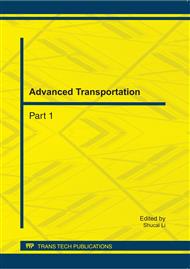p.1149
p.1154
p.1158
p.1162
p.1168
p.1176
p.1181
p.1185
p.1189
Macroscopic Simulation of Pedestrian Flow through a Bottleneck
Abstract:
The paper deals with the macroscopic type modelling of the unidirectional pedestrian flow moving through a corridor with a bottleneck. The macroscopic model of pedestrian flow is the two-dimensional Lighthill-Whitham-Richards model described as a mass conservation equation. The characteristic feature of pedestrian route choice is that pedestrians in the corridor try to minimize the instantaneous travel time and improve the comfort level. The model equation is solved numerically by the discontinuous Galerkin method. Numerical results visualize the ability of the model to predict macroscopic characteristics of pedestrian flow through bottlenecks, i.e. the spatial distribution of the flow speed and density, as well as the formation and dissipation of traffic congestion in the corridor. They also validate that congestion is caused by the limited capacity of the bottleneck.
Info:
Periodical:
Pages:
1168-1175
Citation:
Online since:
September 2011
Authors:
Price:
Сopyright:
© 2011 Trans Tech Publications Ltd. All Rights Reserved
Share:
Citation:


